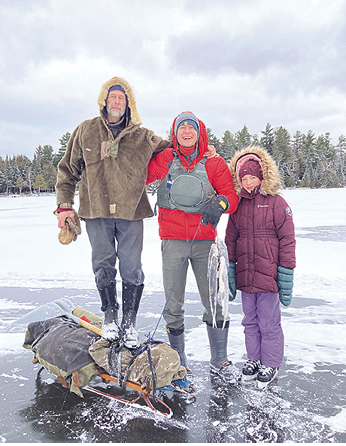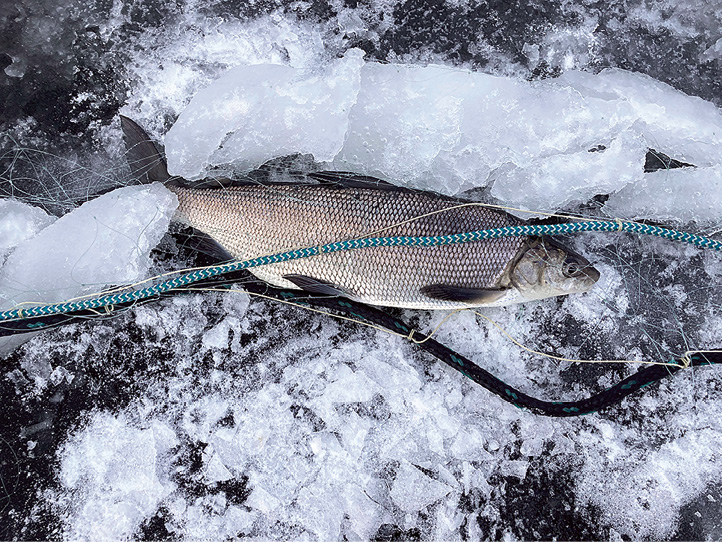How many people have ever been whitefish netting?
According to a 2022 Minnesota DNR press release, only 700 people a year participate in this tradition in Minnesota. While netting has a rich heritage in the state, times have changed: much of today’s fishing crowd employs scanning sonar, navigation apps, and high-speed motorboats to ply the waters. Fishing has gone hi-tech, leaving the original heritage methods of the Native Americans, and early European settlers, behind.
Low-tech netting still has a legal season in Minnesota, and you don’t need a Garmin Livescope to do it. In fact, the beauty of whitefish netting is in its simplicity. Netting these beautiful, nutritious fish is about following the ways of our ancestors, and the Indigenous, to harvest fish for sustenance.
For the Ojibwe, these fish are the adikameg—“the caribou of the water.” The whitefish—netted in the fall—were a major source of winter food for the Ojibwe, equal in importance to caribou meat. Here’s how to learn this heritage fishing method.
To start, whitefish netting is strictly regulated in both Minnesota and Ontario, with an open season in late fall, when whitefish come in shallow to spawn. In Minnesota waters, whitefish netting using gill nets is open to state residents only. A resident whitefish/herring/tullibee harvest license must be purchased by each individual netting in Minnesota ($10, available at any DNR license agent), along with a regular angling license.
In Ontario waters, only dip nets may be used to pursue whitefish—a separate pursuit that involves swinging a net by hand to scoop up whitefish, usually at night, much like smelting.
Gill netting requires simple tools. For Minnesota waters, start with a gill net made by Duluth Nets. This local producer (formerly named H. Christiansen Company) was originally founded in 1886 to serve the commercial fishing industry. Yes, they have over 135 years of whitefish gill net production experience on the North Shore.

Whitefish netters can use a 100-foot-long by 3-foot-deep gill net in approved lakes (see the MN DNR’s yearly Whitefish and Cisco Sport Gill Netting Regulations to identify water bodies with a whitefish netting season—about 100 lakes in all in Minnesota).
Duluth Nets makes ingenious sinking nets with a bottom lead core rope, and a top foam core rope. When deployed in the water, the net’s bottom rope sinks to bottom, while the top rope rises toward the surface, thereby keeping the net taut top to bottom. In between is a monofilament mesh pattern with thousands of small openings for fish to swim into, then get caught by their gills upon trying to retreat.
The art of “hanging” nets is knowing the spacing of how many meshes to put in a certain interval depending on the species and size of fish targeted, then securing (hanging) the mesh on ropes.
Bryan Sederberg, co-owner of Duluth Nets with his brother Derek Sederberg, says that the company’s business provides a source of cultural continuity. “We view the whitefish season as an opportunity to supply the local fishing culture that Minnesota is so well known for. We enable people to experience netting, and what it historically provided for people, especially in this area.”
A whitefish gill net runs $120 and can be purchased online or in person at Duluth Nets’ retail store in Rice Lake, MN.
These nets are a piece of history that you can use productively today. “Historically, lead weights were tied to the bottom of the net, and simple cork floats or sponges were tied to the top,” says Sederberg. “Today, we’re using a very sophisticated braided polypropylene leadcore-style bottom rope. Same thing on the top rope, with a foam core and a braided polypropylene jacket. That makes things a lot easier on the netters.”
Now that you’ve got your net, you’ll need at least a 2-foot-tall buoy to mark your net in the water. This alerts motor boaters to avoid driving through your net with their propeller. You must also attach an identification tag with your name and address to the buoy. Nets may not be set in any water deeper than 6 feet, and cannot be set within 50 feet of another net. Finally, a person may not have any angling equipment (rod and reel) in their possession while netting.
Anchor each end of the 100-foot-long net to the bottom with a rock or other heavy weight, and make sure the net is stretched to the fullest for proper tension.
Now that you’ve got the equipment, you need to learn strategy. You’re aiming for rocky reefs where whitefish come to spawn. The season runs roughly late October through early December, but varies from lake to lake, so follow the netting “schedule” released each October by the DNR.
The DNR website explains the reasoning behind each lake having its own schedule: “The DNR bases netting schedules on expected water temperatures, fish abundance and the vulnerability of game fish. As the water temperature cools, game fish head to deeper water and whitefish and cisco come to shallow water for fall spawning. Netting is allowed when there is little chance that game fish populations would be harmed by recreational netting in shallow water. Game fish incidentally taken in nets must be returned to the water immediately.”
Once you’ve chosen a location, you need to get out on the water. This is easier said than done in late fall. Netting from a canoe is a challenging endeavor in fierce November winds. Conversely, you can wait until ice forms on the lake, and take your chances walking on first ice. This method will require using a hand-powered ice saw to open a hole to deploy the net through. Either way, be prepared for cold hands, whipping winds, and lots of wet, icy equipment. A pair of insulated, rubber gloves can be critical.
Nets are deployed in late afternoon, and left in the water overnight, to catch the whitefish swimming through their spawning grounds. Nets may not be set or lifted between sunset and sunrise.
The next morning, the anticipation runs incredibly high as you paddle out, or brave the ice, to go check your net. It’s an entirely different feeling than fishing with a rod and reel. You’ve been “fishing” all night long—back in your cozy shelter on shore. You lift the net with great expectation, and can often feel the weight of the fish even before you can see them. You may even observe the net “moving”—a tell-tale sign that there are fish in the net. When netting through clear fresh ice, you may see the golden forms of the whitefish swimming below you, trying unsuccessfully to get unstuck from the net.
Ruurd Schoolderman, a netter from Duluth, says that whitefish netting is a good excuse to get out in the shoulder season, when most people are either in the woods hunting, or sitting at home on the couch. He highlights that whitefish “are a different species that are hard to target in other times of the year. It’s one of the best game fish you can eat.”
Schoolderman adds that netting is “for the hearty,” and requires some calculated risks. It’s a type-two fun that requires mental preparation to prepare for different conditions you may encounter, such as high winds or early ice. “OK, how am I going to approach this? On our last trip, we had a plan A, B, and C, and we had to go over all the different scenarios to find an approach that worked,” says Schoolderman.
Keeping the whitefish netting tradition alive is a way to get connected with our past, provide extremely healthy fare for the dinner table, and gain a rewarding heritage experience.

